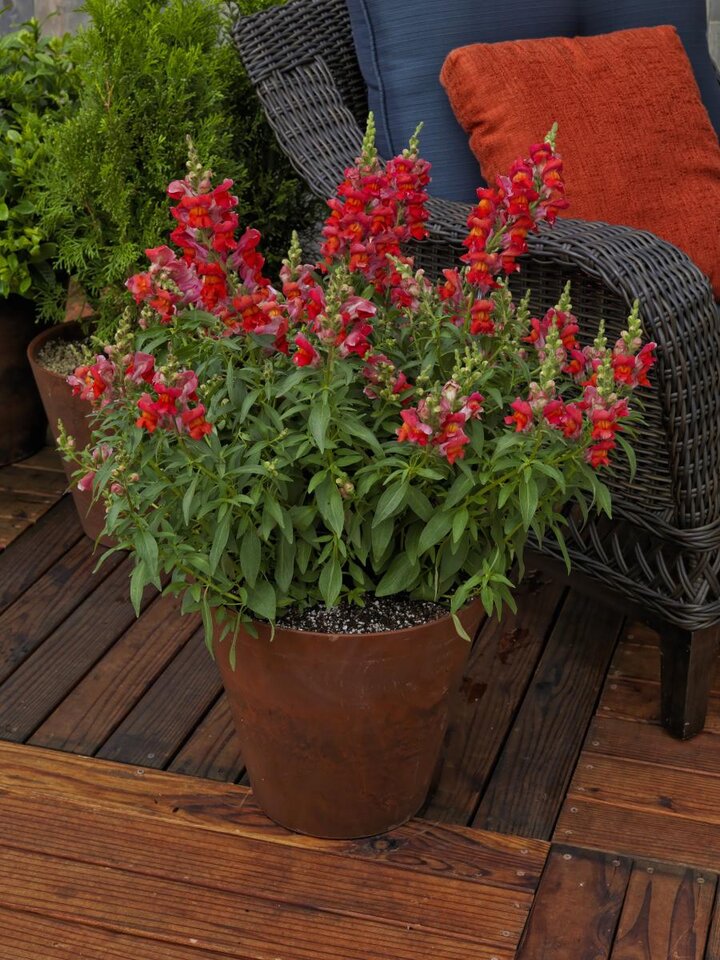Sarah Browning, Nebraska Extension Educator

This year theNational Garden Bureaufeatures Snapdragon, Antirrhinum majus, as its annual flower of the year. Snapdragon is often thought of as an old-fashioned flower, evoking childhood memories of a grandparents’ garden. But snapdragons are an easy to grow, multi-purpose plant, which add great color, fragrance and pollinator habitat to any garden. If you haven’t used snapdragons in your gardens in recent years, give them another try. You’ll be happy you did.
Snapdragons are native to the Mediterranean, parts of the Middle East and Northern Africa. In those areas they are perennial plants, but in Nebraska snapdragons do not survive winter so are treated as annuals.
Plants get their common name from their flower shape, which if you use a little imagination resembles a dragon’s head. Flowers consist of an upper lip and lower lip, made up of fused petals, which join together at their base to form a tube. Flowers come in a wide range of colors and bicolors.
are attractive to pollinators, including hummingbirds, bumble bees and other larger size bees. They’re not the best honey bee attractor because bees have to push their way in between the two flower lips to get to the pollen inside. But snapdragons are also not a preferred food choice of deer and rabbits, so can be a good choice for gardens with a history of wildlife damage. Snapdragons also make great cut flowers.

Variety of Heights
Plants are available in a variety of heights and growth habits. Dwarf types are currently the most popular at garden centers; plants reach 6-10 inches tall and 10-12 inches wide. Floral Showers is one of the most common dwarf series, including thirteen different flower colors and two bicolors. It grows well in containers and patio planters. Other dwarf lines include Floral Carpet, Magic Carpet and Tahiti.
Intermediate types range in size from 16-24 inches tall and 12-18 inches wide. Look for plants in the Chimes, Crown, Freesong, LaBella and Montego series.
Tall snapdragons are 24-30 inches or taller and 14-16 inches in width. Look for the Panorama, Rocket and Sonnet series. In the garden, stake tall types to prevent them from falling over and breaking. They can easily become top heavy because of their large flowers.
Snaptastic is a new type of intermediate height snapdragon that combines the bushy habit of dwarf types with taller flower stems typical of the medium types. This cultivar offers better branching in the garden and requires less staking, but retains the classic look of traditional snapdragons.
The Candy Showers series is also unique as the first trailing snapdragon series from seed. It is ideal for hanging baskets, window boxes, and patio containers.
In the Garden
Snapdragons are cold tolerate plants, so they can be planted early in spring along with pansies and violas. They do best in full sun locations and are tolerant of many different soil types, as long as it is well-drained. Incorporating additional organic matter into heavy clay soil is a good idea and will reward you with healthier plants due to better root systems.
Purchase transplants or grow your own from seed. Sow seeds indoors 8-10 weeks before the last spring frost to have nice-sized transplants ready for your garden. Snapdragon seeds are very small and require light for germination, so use a seed starting soil mix and press the seeds lightly onto the top of the soil. Expect germination in two to three weeks at 55º-60ºF. Growing under cooler conditions is preferable since it results in shorter, studier plants.
Flowering may slow down during the hottest part of summer. To get plants over this late summer lull, keep plants well-watered, fertilize weekly with a water-soluble product and deadhead as old flowers fade. Deadheading prevents plants from putting energy into seed production. Cut stems back to a sturdy point, which will be strong enough to hold up the new growth.
For more information on this year's featured plants, visit the National Garden Bureau. The National Garden Bureau recognizes and thanks David Kuack and Syngenta Flowers as author and contributor to this fact sheet.
Images from the National Garden Bureau.